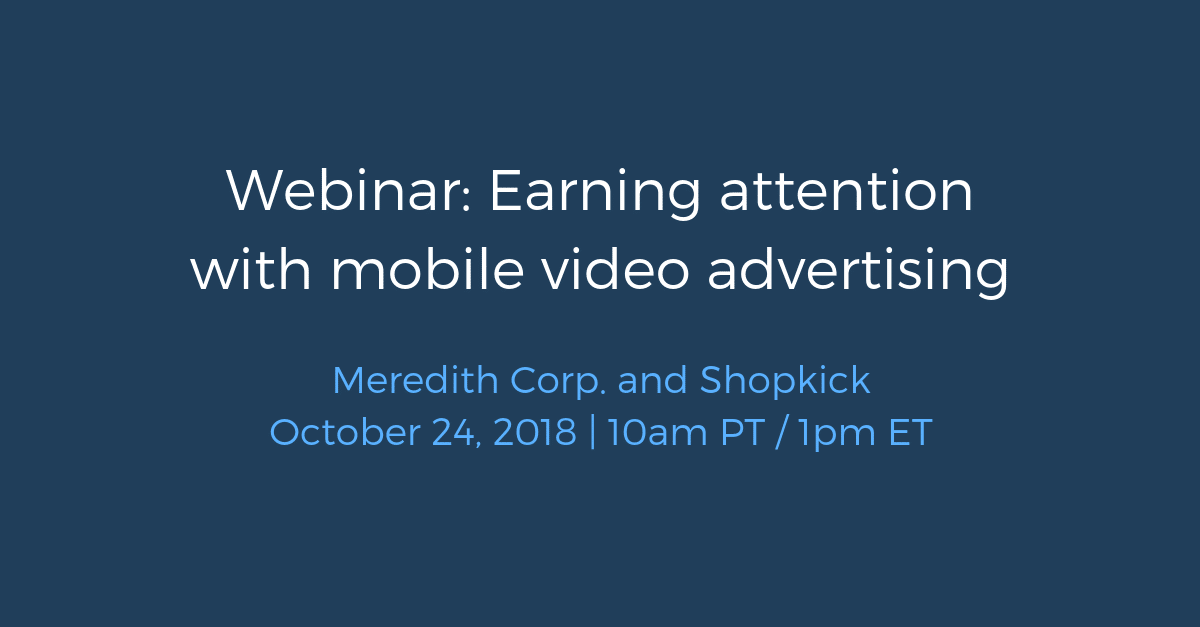When using video marketing strategies in the shopping aisle, brands must straddle a fine line between aiding the consumer and disrupting them. Continue reading “3 in-store video marketing ideas to win consumers on their path to purchase”
Category: Video
Engaging customers in retail with video greetings can lead to better brand retention
Personalization is a significant factor in engaging customers in retail. Continue reading “Engaging customers in retail with video greetings can lead to better brand retention”
Video marketing strategies that use augmented reality in retail
London’s National Theater recently made headlines for its new augmented reality (AR) glasses. Continue reading “Video marketing strategies that use augmented reality in retail”
Webinar: Earning attention with mobile video advertising
Ad skipping, fleeting attention, distraction, clutter. In today’s crowded digital environment, earning attention with mobile video advertising can be challenging. In fact, 59% of marketers’ digital ad budgets are allocated to digital video, and that number is only expected to rise.
Continue reading “Webinar: Earning attention with mobile video advertising”
eBook: How Successful Brands Avoid the 5 Biggest Mobile Video Advertising Obstacles
Consumer video consumption has increased so dramatically year over year that, according to research from the IAB, 59% of marketers’ digital ad budgets are currently allocated to digital and mobile video, and marketers expect to increase that investment by 53% in the coming year. Continue reading “eBook: How Successful Brands Avoid the 5 Biggest Mobile Video Advertising Obstacles”
Shopkick turns 9! A look back on our year
August marks Shopkick’s 9th birthday, and to celebrate, we’re taking a look back on all that we’ve accomplished in the past year. Continue reading “Shopkick turns 9! A look back on our year”
5 video marketing tips to engage and enthuse an audience
The 2018 video advertising trends that will shape 2019 and beyond
Three must know video marketing statistics
Knowing what your competitors are doing in terms of marketing initiatives is one of the key parts of building a campaign, and you can gain a lot of insight from video marketing statistics for 2018. Understanding competitors’ practices reveals how they’re reaching out to consumers and, sometimes, what you should be trying as well. Using these statistics can help brands develop ideas for differentiation. Video marketing statistics reveal what others in the industry are doing and how a brand can stand out in an attempt to gain market share.
 Choosing a slant, an audience, and a platform for video ads can be a challenge for brands, as the number of choices can almost overwhelm. There are thousands of platforms and audiences to approach and millions of ways to deliver messages. Brands need to be able to segment themselves and find the ideal place to share their category of goods. Gaining insight from three key video marketing statistics can help guide and improve your video marketing decisions.
Choosing a slant, an audience, and a platform for video ads can be a challenge for brands, as the number of choices can almost overwhelm. There are thousands of platforms and audiences to approach and millions of ways to deliver messages. Brands need to be able to segment themselves and find the ideal place to share their category of goods. Gaining insight from three key video marketing statistics can help guide and improve your video marketing decisions.
Video Marketing Statistic #1: Marketers Are Increasing Focus on Video
Most marketers plan on boosting their budgets for video marketing in 2018. In one survey, about 85% of digital marketing professionals plan on increasing their investment in video in 2018. That’s across all major platforms, including:
- Social media: About 61% of mobile marketers plan to use social media sites like Facebook, Instagram, and Twitter to share video advertising this year. The rapid increase in marketers using video advertising on social media platforms could be due to the increased development of native platforms within these sites. Facebook is one such site that is increasing its support in video, to include adding options for mobile video. The increased access to social platform video support is a driving factor for why so many brands are choosing to leverage it.
- In-app advertising: Marketers are also looking to in-app advertising for mobile video, where advertisements appear while consumers are using apps. This category also accounts for shopping apps, like Shopkick, which are seeing a rapid increase in popularity with consumers.
- Branded video advertising: Brands making their own videos and hosting them on their own sites will also grow this year. When a landing page includes a video, it’s estimated that up to 86% of users will go on to view additional site content after viewing the video. This is a key factor in why brands are upping their native video content production.
Of course, there are a few downsides to increased video advertising spending. First, many brands will find it more difficult to gain attention as competitors also roll out video offerings. In addition, increased ad spending on video advertising has also increased the risk of fraud.
Video Marketing Statistic #2: Scammers Now Focused on Video
Video is becoming a prime target for ad fraud as it has become a lucrative area for scammers. Video makes up about half, 45%, of ad spend for companies, but it accounts for 64% of ad fraud. This fraud occurs several ways:
- Pre-roll mislabeling: In video advertising, a brand can purchase advertisements to run prior to editorial content, often referred to as pre-roll. In some cases, however, a disreputable firm may instead play video in a pop-up window, with no editorial content. The issue with this is that advertisers will pay for a more expensive editorial spot with high conversion potential but will instead get impressions from one of these low conversion potential pop-up windows.
- False traffic: In this style of advertising fraud, fraudsters set up bot networks that send fake traffic to view videos. The advertiser pays for real, human traffic, but instead gets machine generated traffic.
- Piracy: Piracy, in relation to ad fraud, comes when sites deliver pirated content at the expense of legitimate sponsors. In 2016, digital ad revenue from content that infringed on copyrights reached $111 million, forcing many online advertising organizations to begin cracking down on copyright violations.
- False completions: Fraud also occurs when a viewer scrolls through a feed and sees only 2 seconds of a 30 second video, yet the marketer is charged for a full 30-second view.
It can be difficult to fight these types of fraud because spotting them can be a challenge. To avoid paying for fraudulent ads, companies should work with marketers that hold industry credentials, like TAG and MRC certifications. Those credentials show that a company has met certain standards, so brands can trust the methods they use for gaining and measuring traffic. This is especially important for brands as video viewing switches to mobile devices.
Video Marketing Statistic #3: Mobile Makes the Difference
Mobile video advertisements grew by more than one-third in 2017, and it was reported that consumers spend around half an hour every day viewing these advertisements. It appears that mobile video demand and supply are increasing simultaneously, as consumers seek more mobile content and brands hustle to deliver it.
One way to stand out with mobile video advertising is to take an in-app based approach.
Mobile video advertising is in a massive growth phase right now, which is why brands need to seek unique ways to leverage it. An influx of innovative new advertising platforms makes for exceptional opportunities for brands, as it’s possible to get in on the best advertising platforms while they’re still in their infancy—before they’re overrun by competition. One way to stand out with mobile video advertising is to take an in-app based approach, such as with shopping apps that allow brands to share video advertising in a platform that leverages multiple strategies for incentivizing sales.
These video marketing statistics for 2018 provide insight on what the competition is doing in terms of ad spending. They also show us areas of risk—like increased ad fraud—and reveal what platforms to focus on. Understanding what is driving competitors to take the steps they do with video lends insights brands can utilize in their own marketing campaigns.
Shopkick is heavily focused on the impact of video and offers our partners the opportunity to leverage it through the power of mobile apps. For more information, contact us.
Image courtesy of Onephoto
The top mobile advertising platform features CPG brands need
Often, when we talk about the top mobile advertising platform options for CPG brands, we focus on what CPG customers want and need. Continue reading “The top mobile advertising platform features CPG brands need”
Why the retail mobile app isn’t a temporary trend
The retail mobile app isn’t a fad. It’s an evolving medium of communication between the consumer and the store. Continue reading “Why the retail mobile app isn’t a temporary trend”
CPG video advertising monetization in the age of the mobile app
Often, the strategies for video advertising monetization are discussed not by content producers, but by the publishers who make money off those advertisements. Continue reading “CPG video advertising monetization in the age of the mobile app”












